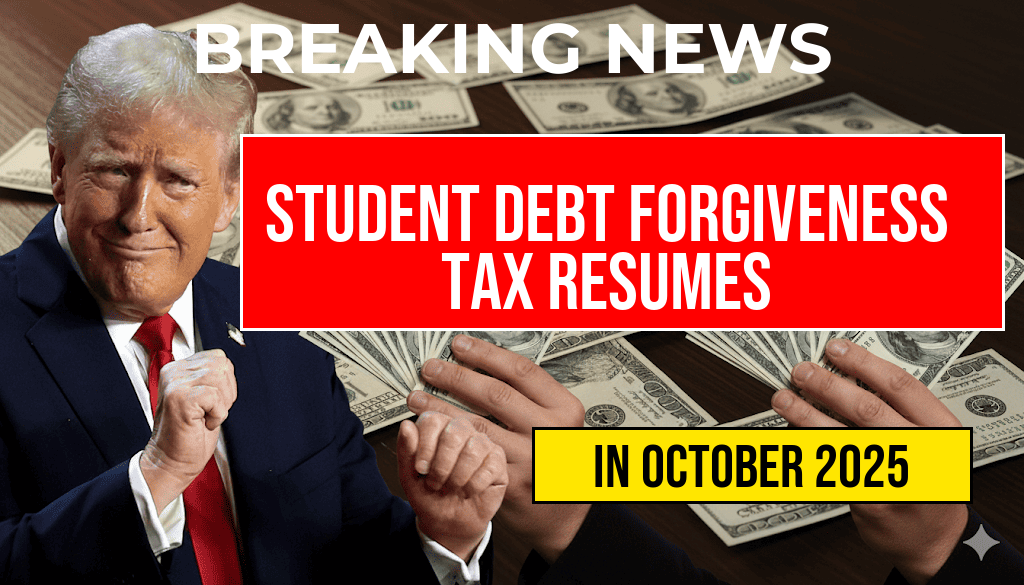Student Debt Forgiveness Tax Resumes January 1 as $20,000 Relief Disappears
Starting January 1, 2024, millions of Americans will face a significant change in their student loan repayment landscape as the temporary exemption on federal student debt forgiveness expires. The Biden administration’s earlier relief measures, which temporarily shielded borrowers from tax liabilities on canceled debt up to $20,000, are no longer in effect. This shift means that borrowers who received debt forgiveness during the pandemic-related relief programs will now be subject to federal income tax on the forgiven amounts, potentially leading to unexpected tax bills. Experts warn that this development could impact borrowers’ financial stability, especially those relying heavily on debt relief programs that have been in place since 2021.
Background on Student Debt Relief Measures
The COVID-19 pandemic prompted unprecedented changes to federal student loan policies, including paused repayment periods and debt forgiveness initiatives. The federal government implemented several relief measures aimed at alleviating financial strain, including the Student Loan Forgiveness Program that canceled up to $20,000 for qualifying borrowers. These measures were designed to promote economic recovery and provide temporary financial breathing room amid ongoing economic uncertainties.
In August 2022, the Biden administration announced a plan to forgive up to $20,000 in federal student loans for borrowers earning under $125,000 annually. While the initiative was met with widespread support, it faced legal challenges and delays, culminating in a Supreme Court ruling that prevented the administration from implementing the broader forgiveness plan in June 2023. However, the administration continued to offer targeted relief programs, including income-driven repayment plan adjustments and partial forgiveness options.
The Return of Tax Liability on Forgiven Debt
One of the critical aspects of the relief measures was the temporary suspension of tax obligations related to student loan forgiveness. Under the American Rescue Plan Act of 2021, forgiven student debt was excluded from taxable income through December 31, 2025. This exemption provided significant relief to borrowers, allowing them to benefit from debt cancellation without facing immediate tax consequences.
Effective January 1, 2024, this exemption expires, and forgiven debt will once again be considered taxable income at the federal level. Borrowers who received debt forgiveness during the pandemic relief period might find themselves facing unexpected tax bills when they file their 2023 tax returns in early 2024. For example, a borrower who received $10,000 in debt cancellation could see a tax liability of several thousand dollars, depending on their income bracket and state tax laws.
Implications for Borrowers
| Forgiven Amount | Estimated Federal Tax Liability (at 22% rate) | Additional State Tax (varies by state) |
|---|---|---|
| $10,000 | $2,200 | Varies |
| $20,000 | $4,400 | Varies |
Many borrowers had counted on the previous relief to help manage their student debt burden without additional tax burdens. The resumption of taxation on forgiven debt could prompt some to reconsider their repayment strategies, potentially leading to increased financial stress. Financial advisors warn that borrowers should prepare for possible tax implications and consider consulting tax professionals to navigate the upcoming tax season.
States may also impose their own taxes on forgiven student debt, further complicating the financial picture for some borrowers. Not all states treat discharged student loans as taxable income, but many do, which could add hundreds or thousands of dollars to the tax bill for residents in those jurisdictions. The Forbes warns that failure to plan ahead could result in unexpected penalties or cash flow issues during tax season.
What Borrowers Should Do Now
- Review your loan forgiveness documentation: Confirm if you received any debt cancellation during the relief period and keep records for tax purposes.
- Calculate potential tax liabilities: Use online calculators or consult with a tax professional to estimate your upcoming tax bills based on forgiven amounts.
- Explore repayment options: Consider income-driven repayment plans or refinancing options to manage future obligations more effectively.
- Stay informed about state-specific rules: Check with your state’s department of revenue or tax authority for guidance on state tax treatment of forgiven student debt.
Looking Ahead
The expiration of the student debt forgiveness tax exemption underscores ongoing debates about how best to support borrowers while managing fiscal policy. While the Biden administration maintains that targeted relief measures will continue where possible, the resumption of tax liabilities complicates the landscape for many Americans. Advocacy groups are urging policymakers to revisit the issue, emphasizing the potential financial hardship posed by the return of taxable forgiveness.
As the new year begins, borrowers are encouraged to assess their individual circumstances carefully and seek professional advice if needed. The shifting policy environment highlights the importance of proactive financial planning amid evolving federal policies on student debt relief.
Frequently Asked Questions
When does the student debt forgiveness tax relief period end?
The student debt forgiveness tax relief ends on December 31. Starting January 1, borrowers will be responsible for paying taxes on the forgiven amount, as the $20,000 relief expires.
What is the impact of the expiration of the $20,000 relief on borrowers?
Borrowers who had previously benefited from the $20,000 relief will now face potential tax liabilities on the forgiven student debt, which could lead to a significant financial burden.
Will the student debt forgiveness be taxed after January 1?
Yes, starting January 1, the forgiven student debt may be considered taxable income under federal law, unless new legislation is enacted to extend or modify the relief.
Are there any options to avoid paying taxes on forgiven student debt?
Borrowers should consider consulting a tax professional to explore potential exemptions or deductions. Some borrowers may qualify for specific income-based tax exclusions or other relief measures.
How can borrowers prepare for the end of the tax relief period?
Borrowers are advised to review their student debt and plan for potential tax liabilities by consulting with a financial advisor and preparing for increased tax payments starting in 2024.

Leave a Reply